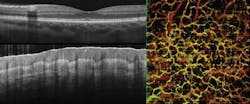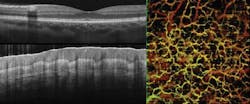Spectral-domain OCT spectrometer addresses sensitivity, fall-off drawbacks
A new optical coherence tomography (OCT) spectrometer from Wasatch Photonics (Logan, UT) offers 250,000 lines/s speeds and roll-off performance that enables deeper sample penetration with higher image clarity. The Cobra-S OCT spectrometer integrates with near-infrared OCT systems for use in spectral-domain OCT applications such as ophthalmology, dermatology, angiography, oncology, and industrial utilities.
The OCT spectrometer includes available feature options for athermal optomechanics to maintain the performance level over a wide range of operating conditions, and is available in multiple configurations to cover different wavelength regions. Also, while most spectral-domain OCT spectrometers provide high resolution and good phase stability, there are drawbacks regarding speed and sensitivity fall-off with depth, explains Nishant Mohan, vice president of the OCT Division at Wasatch Photonics (Durham, NC). But the Cobra-S system, he says, addresses both sensitivity and fall-off issues while maintaining very high resolution and phase sensitivity.
For more information, please visit http://wasatchphotonics.com.

